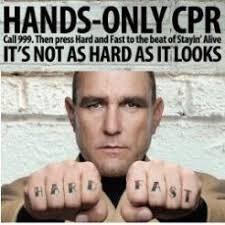What does CPR involve?
- Chest compressions (pumping the heart by external cardiac massage), to keep blood circulation going until the ambulance arrive
- Rescue breathing (inflating the lungs by using mouth-to-mouth resuscitation)
- Recommended ratio of 30 x chest compressions to 2 x rescue breaths
- However, note that even if you haven't received CPR training with rescue breathing, you can still use hands-only CPR (see below)
Hands-only CPR
Some people, such as first aiders, are trained how to deliver ‘rescue breaths’ (mouth-to-mouth ventilation), and doing this in addition to chest compressions remains the recommended treatment for a first response to cardiac arrest. However, if you do not know how to deliver rescue breaths, it is better to deliver ‘hands-only CPR’ (i.e. chest compressions) immediately and without interruption, rather than doing nothing or attempting ‘rescue breathing’ ineffectively.
Vinnie Jones fronted a British Heart Foundation campaign from 2011 urging more people to carry out CPR, showing how hard and fast Hands-only CPR to Stayin' Alive by the Bee Gees can help save the life of someone in cardiac arrest.
